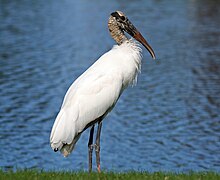| Wood stork | |
|---|---|

| |
| Pond, Tampa Bay, Florida | |
| Scientific classification | |
| Domain: | Eukaryota |
| Kingdom: | Animalia |
| Phylum: | Chordata |
| Class: | Aves |
| Order: | Ciconiiformes |
| Family: | Ciconiidae |
| Genus: | Mycteria |
| Species: | M. americana
|
| Binomial name | |
| Mycteria americana | |

| |
| Geographical distribution of the wood stork. Breeding Year-round Nonbreeding
| |
| Synonyms | |
The wood stork (Mycteria americana) is a large wading bird in the family Ciconiidae (storks). Originally described in 1758 by Carl Linnaeus, this stork is native to the subtropics and tropics of the Americas where it persists in habitats with fluctuating water levels. It is the only stork species that breeds in North America. The head and neck are bare of feathers, and dark grey in colour.[2] The plumage is mostly white, with the exception of the tail and some of the wing feathers, which are black with a greenish-purplish sheen.
Globally, the wood stork is considered to be of least concern by the International Union for Conservation of Nature. In the United States, the wood stork was previously classified as Endangered due to loss of suitable feeding habitat in the Florida Everglades, its historical population stronghold in the country.[3] The species has been subsequently downlisted to Threatened after northward range expansion and increased population size.
- ^ BirdLife International (2016). "Mycteria americana". IUCN Red List of Threatened Species. 2016: e.T22697648A93627312. doi:10.2305/IUCN.UK.2016-3.RLTS.T22697648A93627312.en. Retrieved 12 November 2021.
- ^ "Wood Stork | National Geographic". Animals. 2010-11-11. Archived from the original on May 11, 2017. Retrieved 2020-12-24.
- ^ Ogden J. C. & Patty B. W. (1981) "The recent status of the wood stork in Florida and Georgia". In: Odom RQ, Guthrie JW, editors. Proceedings of the nongame and endangered wildlife symposium (Technical Bulletin WL5). Atlanta, GA, USA: Georgia Department of Natural Resources Game and Fish Division. pp. 97–102.
